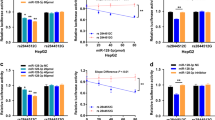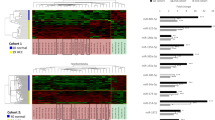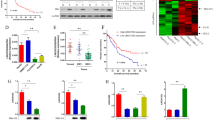Abstract
The necessity for early detection and hence improving the outcome of treatment of hepatocellular carcinoma (HCC) is critical especially in Hepatitis C virus (HCV)-Genotype 4 induced cases. In our current work, we examined the miRNA-152 and DNMT-1 expression in chronic liver disease (CLD) due to HCV genotype 4 infection with/without cirrhosis and HCC patients as an attempt to evaluate the potential benefits of these new circulating, noninvasive, prognostic, epigenetic markers for liver cirrhosis and carcinogenesis of Egyptian patients. Eighty subjects were included in this study, divided into two groups; group I (40 patients) were classified into subgroup Ia (CLD without cirrhosis, n = 18) and subgroup Ib (CLD with cirrhosis, n = 22), group II (CLD patients with HCC, n = 20), and control (Healthy volunteer, n = 20). The expression of miRNA-152 and DNMT-1 genes were analyzed using Real-Time PCR. MiRNA-152 showed a persistent and significant downregulation in all diseased groups, which was in consistence with the progression of the disease toward the HCC stage. DNMT-1 showed upregulation in all diseased groups when compared to control and subgroup Ia. The miRNA-152 was shown to correlate inversely with DNMT-1 in subgroup Ia, Ib and group II (r = −0.557, p < 0.01), (r = −0.850, p < 0.001) and (r = −0.544, p < 0.02) respectively. In addition, miRNA-152 and DNMT-1 showed a diagnostic ability to discriminate between cases of cirrhosis and HCC against CLD without cirrhosis (p < 0.01), while DNMT-1 did not, except between HCC and cirrhotic cases. Furthermore, both genes can be considered as predictor and prognostic parameters for cirrhosis (OR = 1.041, p = 0.043) and (OR = 1.039, p = 0.04) respectively, while miRNA-152 alone is proved as a prognostic marker for HCC (OR = 1.003, p = 0.044). Finally, the persistent reverse correlation between miRNA-152 with DNMT-1 prompts their use as noninvasive prognostic biomarkers for HCV induced liver cirrhosis and HCC in HCV Genotype 4 patients.
This is a preview of subscription content, access via your institution
Access options
Subscribe to this journal
Receive 12 print issues and online access
$259.00 per year
only $21.58 per issue
Buy this article
- Purchase on Springer Link
- Instant access to full article PDF
Prices may be subject to local taxes which are calculated during checkout







Similar content being viewed by others
Change history
22 February 2022
A Correction to this paper has been published: https://doi.org/10.1038/s41417-022-00440-x
22 June 2022
This article has been retracted. Please see the Retraction Notice for more detail: https://doi.org/10.1038/s41417-022-00496-9
References
El-Zanaty F, Way A. Egypt Demographic and Health Survey 2008. Cairo, Egypt: Ministry of Health, El-Zanaty and Associates, and Macro International; 2009.
Ministry of Health and Population [Egypt]. El-Zanaty and Associates [Egypt] and ICF International. Egypt Health Issues Survey 2015. Cairo, Egypt and Rockville, MD, USA: Ministry of Health and Population and ICF International; 2015.
Hanafiah M, Groeger J, Flaxman D, Wiersma T. Global epidemiology of hepatitis C virus infection: new estimates of age-specific antibody to HCV seroprevalence. Hepatology. 2013;57:1333.
Zoheiry M, Hasan S, El-Ahwany E, Nagy F, Taleb H, Nosseir M, et al. Serum markers of epithelial mesenchymal transition as predictors of HCV-induced liver fibrosis, cirrhosis and hepatocellular carcinoma. Electron Physician 20. 2015;7:1626.
Schanzer D, Paquette D, Lix L. Historical trends and projected hospital admissions for chronic hepatitis C infection in Canada: a birth cohort analysis. CMAJ. 2014;2:139.
Brian P, Thomas J, Zahra Y, Yousef F, Zobair M. The changing landscape of hepatitis C virus therapy: focus on interferon-free treatment. Ther Adv Gastroenterol. 2015;8:298.
Adams L, George J, Burgianesi E, Rossi E, De-Boer W, Van-der P, et al. Complex noninvasive fibrosis models are more accurate than simple models in non-alcoholic fatty liver diseases. J Gastroenterol Hepatol. 2011;26:1536.
Sharma S, Khalili K, Nguyen G. Non-invasive diagnosis of advanced fibrosis and cirrhosis. World J Gastroenterol. 2014;20:16820.
Li X, Wang Y, Wang H, Huang C, Huang Y, Li J. Endoplasmic reticulum stress is the crossroads of autophagy, inflammation, and apoptosis signaling pathways and participates in liver fibrosis. Inflamm Res. 2015;64:1.
Jiang F, Parsons C, Stefanovic B. Gene expression profile of quiescent and activated rat hepatic stellate cells implicates Wnt signaling path way inactivation. J Hepatol. 2006;45:401.
De-Minicis S, Seki E, Uchinami H, Kluwe J, Zhang Y, Brenner D, et al. Gene expression profiles during hepatic stellate cell activation in culture and in vivo. Gastroenterology. 2007;132:1937.
Coll M, El-Taghdouini A, Perea L, Mannaerts I, Vila-Casadesús M, Blaya D, et al. Integrative miRNA and gene expression profiling analysis of human quiescent hepatic stellate cells. Sci Rep. 2015;5:1549.
Reinhart B, Slack F, Basson M, Pasquinelli A, Bettinger J, Rougvie A, et al. The 21-nucleotide let-7 RNA regulates developmental timing in Caenorhabditis elegans. Nature. 2000;403:901.
Roderburg C, Luedde T. Circulating microRNAs as markers of liver inflammation, fibrosis and cancer. J Hepatol. 2014;61:1434.
Lambrecht J, Inge M, Leo A. The role of miRNAs in stress responsive hepatic stellate cells during liver fibrosis. Front Physiol. 2015;209:1.
Varambally S, Cao Q, Mani R, Shankar S, Wang X, Ateeq B, et al. Genomic loss of microRNA-101 leads to overexpression of histone methyltransferase EZH2 in cancer. Science. 2008;322:1695.
Balaguer F, Link A, Lozano J, Cuatrecasas M, Nagasaka T, Boland C, et al. Epigenetic silencing of miR-137 is an early event in colorectal carcinogenesis. Cancer Res. 2010;70:6609.
Dang Y, Zeng J, He R, Rong M, Luo D, Chen G. Effects of miR-152 on cell growth inhibition, motility suppression and apoptosis induction in hepatocellular carcinoma cells. Asian Pac J Cancer Prev. 2014;15:4969.
Zhai R, Kan X, Wang B, Du H, Long Y, Wu H, et al. miR-152 suppresses gastric cancer cell proliferation and motility by targeting CD151. Tumour Biol. 2014;35:11367.
Li Y, Xiyun D, Xiaomin Z, Xiaoning P. The Role of Mir-148a in Cancer. J Cancer. 2016;7:1233.
Ramassone A, Pagotto S, Veronese A, Visone R. Epigenetics and microRNAs in cancer. Int J Mol Sci. 2018;19:459.
Braconi C, Huang N, Patel T. MicroRNA-dependent regulation of DNA methyltransferase-1 and tumor suppressor gene expression by interleukin-6 in human malignant cholangiocytes. Hepatology. 2010;51:881.
Huang J, Wang Y, Guo Y, Sun S. Down-regulated microRNA-152 induces aberrant DNA methylation in hepatitis B virus–related hepatocellular carcinoma by targeting DNA methyltransferase 1. Hepatology. 2010;52:60.
Bian E, Zhao B, Huang C, Wang H, Meng X, Wu B, et al. New advances of DNA methylation in liver fibrosis, with special emphasis on the crosstalk between microRNAs and DNA methylation machinery. Cell Signal. 2013;25:1837.
Huang J, Yu X, Fries J, Zhang L, Odenthal M. MicroRNA function in the profibrogenic interplay upon chronic liver disease. Int J Mol Sci. 2014a;15:9360.
Bruix J, Sherman M. American Association for the Study of Liver Diseases (AASLD) practice guidelines. management of hepatocellular carcinoma: an update. Hepatology. 2011;53:1020.
Wang X. MiRDB: a microRNA target prediction and functional annotation database with a wiki interface. RNA. 2008;14:1012.
Kindrat I, Tryndyak V, de Conti A, Shpyleva S, Mudalige T, Kobets T, et al. MicroRNA-152-mediated dysregulation of hepatic transferrin receptor 1 in liver carcinogenesis. Oncotarget 12. 2016;7:1276.
Liu X, Li J, Qin F, Dai S. miR-152 as a tumor suppressor microRNA: target recognition and regulation in cancer. Oncol Lett. 2016;11:3911.
Tsuruta T, Kozaki K, Uesugi A, Furuta M, Hirasawa A, Imoto I, et al. miR-152 is a tumor suppressor microRNA that is silenced by DNA hypermethylation in endometrial cancer. Cancer Res. 2011;71:6450.
Huang S, Xie Y, Yang P, Chen P, Zhang. HCV core protein-induced downregulation of microRNA-152 promoted aberrant proliferation by regulating Wnt1 in HepG2 cells. PLoS One 9. 2014b;9:81730.
Miquelestorena-Standley E, Tallet A, Collin C, Piver E, De-Muret A, Salamé E, et al. Interest of variations in microRNA-152 and -122 in a series of hepatocellular carcinomas related to hepatitis C virus infection. Hepatol Res. 2018;48:566.
Jair K, Bachman K, Suzuki H, Ting A, Rhee I, Yen R, et al. De novo CpG island methylation in human cancer cells. Cancer Res. 2006;66:682.
Albrengues J, Bertero T, Grasset E, Bonan S, Maiel M, Bourget I, et al. Epigenetic switch drives the conversion of fibroblasts into proinvasive cancer-associated fibroblasts. Nat Commun. 2015;6:10204.
Nagai M, Nakamura A, Makino R, Mitamura K. Expression of DNA (5-cytosin)- methyltransferases (DNMTs) in hepatocellular carcinomas. Hepatol Res. 2003;26:186.
Arora P, Kim E, Jung J, Jang K. Hepatitis C virus core protein downregulates E-cadherin expression via activation of DNA methyltransferase 1 and 3b. Cancer Lett. 2008;261:244.
Yu F, Lu Z, Chen B, Wu X, Dong P, Zheng J. Salvianolic acid B-induced microRNA-152 inhibits liver fibrosis by attenuating DNMT-1-mediated Patched1 methylation. J Cell Mol Med. 2015;19:2617.
Lu Z, Du M, Qian L, Zhang N, Gu J, Ding K, et al. MiR-152 functioning as a tumor suppressor that interacts with DNMT-1 in nasopharyngeal carcinoma. Onco Targets Ther. 2018;11:1733.
Lan H, Lu H, Wang X, Jin H. MicroRNAs as potential biomarkers in cancer: opportunities and challenges. Biomed Res Int. 2015;2015:1.
Nelson H, Kazuaki C. MicroRNAs as biomarkers for liver disease and hepatocellular carcinoma. Int J Mol Sci 24. 2016;17:280.
Rupaimoole R, Slack F. MicroRNA therapeutics: towards a new era for the management of cancer and other diseases. Nat Rev Drug Disco. 2017;16:203.
Pallante P, Visone R, Ferracin M, Troncone G. MicroRNA deregulation in human thyroid papillary carcinomas. Endocrine-Related Cancer. 2006;13:497.
Acknowledgements
We are very grateful to all anonymous donors of the blood samples used in this study. Dr. Mahmoud Khalifa, mahmoud.khalifa@azhar.edu.eg, Faculty of Science, Al-Azhar University, in addition of his co-authorship participation, provided valuable help in writing the manuscript and editing the revised manuscript, both for language as well as scientific issues.
Author information
Authors and Affiliations
Corresponding author
Ethics declarations
Conflict of interest
The authors declare that they have no conflict of interest.
Additional information
Publisher’s note: Springer Nature remains neutral with regard to jurisdictional claims in published maps and institutional affiliations.
This article has been retracted. Please see the retraction notice for more detail: https://doi.org/10.1038/s41417-022-00496-9
About this article
Cite this article
El-Araby, R.E., Khalifa, M.A., Zoheiry, M.M. et al. RETRACTED ARTICLE: The interaction between microRNA-152 and DNA methyltransferase-1 as an epigenetic prognostic biomarker in HCV-induced liver cirrhosis and HCC patients. Cancer Gene Ther 27, 486–497 (2020). https://doi.org/10.1038/s41417-019-0123-9
Received:
Revised:
Accepted:
Published:
Issue Date:
DOI: https://doi.org/10.1038/s41417-019-0123-9
This article is cited by
-
Interaction between HOTTIP, H19, and HOTAIR long noncoding RNAs and miRNA-152 in cases of HCC caused by HCV infection
Beni-Suef University Journal of Basic and Applied Sciences (2024)



